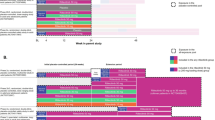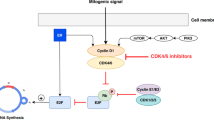Abstract
Purpose
The metabolism of ifosfamide is a delicate balance between a minor activation pathway (4-hydroxylation) and a mainly toxification pathway (N-dechloroethylation), and there remains uncertainty as to the optimal intravenous schedule.
Methods
This study assesses ifosfamide pharmacokinetics (PK) according to two standard schedules. Using a 1:1 randomized trial design, we prospectively evaluated ifosfamide PK on two consecutive cycles of 3 g/m²/day for 3 days (9 g/m²/cycle) given in one of two schedules either by continuous infusion (CI) or short (3 h) infusion. Highly sensitive analytical methods allowed determination of concentrations of ifosfamide and the key metabolites 4-hydroxy-ifosfamide, 2- and 3-dechloroethyl-ifosfamide.
Results
Extensive PK analysis was available in 12 patients and showed equivalence between both schedules (3 h versus CI) based on area under the curves (μmol/l × h) for ifosfamide, 4-hydroxy-ifosfamide, 2- and 3-dechloroethyl-ifosfamide (9,379 ± 2,638 versus 8,307 ± 1,995, 152 ± 59 versus 161 ± 77, 1,441 ± 405 versus 1,388 ± 393, and 2,808 ± 508 versus 2,634 ± 508, respectively, all P > 0.2). The classical auto-induction of metabolism over the 3 days of infusion was confirmed for both schedules.
Conclusion
This study confirms similar PK for both active and toxic metabolites of ifosfamide in adult cancer patients when 9 g/m² of ifosfamide is administered over 3 days by CI or daily 3-h infusions.

Similar content being viewed by others
References
Antman KH, Ryan L, Elias A, Sherman D, Grier HE (1989) Response to ifosfamide and mesna: 124 previously treated patients with metastatic or unresectable sarcoma. J Clin Oncol 7:126–131
Boddy AV, Cole M, Pearson AD, Idle JR (1995) The kinetics of the auto-induction of ifosfamide metabolism during continuous infusion. Cancer Chemother Pharmacol 36:53–60
Boddy AV, English M, Pearson AD, Idle JR, Skinner R (1996) Ifosfamide nephrotoxicity: limited influence of metabolism and mode of administration during repeated therapy in paediatrics. Eur J Cancer 32A:1179–1184
Boddy AV, Idle JR (1992) Combined thin-layer chromatography-photography-densitometry for the quantification of ifosfamide and its principal metabolites in urine, cerebrospinal fluid and plasma. J Chromatogr 575:137–142
Boddy AV, Proctor M, Simmonds D, Lind MJ, Idle JR (1995) Pharmacokinetics, metabolism and clinical effect of ifosfamide in breast cancer patients. Eur J Cancer 31A:69–76
Boddy AV, Yule SM (2000) Metabolism and pharmacokinetics of oxazaphosphorines. Clin Pharmacokinet 38:291–304
Boddy AV, Yule SM, Wyllie R, Price L, Pearson AD, Idle JR (1995) Comparison of continuous infusion and bolus administration of ifosfamide in children. Eur J Cancer 31A:785–790
Brain EG, Yu LJ, Gustafsson K, Drewes P, Waxman DJ (1998) Modulation of P450-dependent ifosfamide pharmacokinetics: a better understanding of drug activation in vivo. Br J Cancer 77:1768–1776
Bruggemann SK, Radike K, Braasch K, Hinrichs J, Kisro J, Hagenah W, Peters SO, Wagner T (2006) Chloroacetaldehyde: mode of antitumor action of the ifosfamide metabolite. Cancer Chemother Pharmacol 57:349–356
Cerny T, Castiglione M, Brunner K, Kupfer A, Martinelli G, Lind M (1990) Ifosfamide by continuous infusion to prevent encephalopathy. Lancet 335:175
Cerny T, Kupfer A, Zeugin T, Brunner KW (1990) Bioavailability of subcutaneous ifosfamide and feasibility of continuous outpatient application in cancer patients. Ann Oncol 1:365–368
Chang TK, Weber GF, Crespi CL, Waxman DJ (1993) Differential activation of cyclophosphamide and ifosphamide by cytochromes P-450 2B and 3A in human liver microsomes. Cancer Res 53:5629–5637
Collins JM, Grieshaber CK, Chabner BA (1990) Pharmacologically guided phase I clinical trials based upon preclinical drug development. J Natl Cancer Inst 82:1321–1326
Goren MP, Wright RK, Pratt CB, Pell FE (1986) Dechloroethylation of ifosfamide and neurotoxicity. Lancet 2:1219–1220
Hines RN, McCarver DG (2002) The ontogeny of human drug-metabolizing enzymes: phase I oxidative enzymes. J Pharmacol Exp Ther 300:355–360
Ihaka R, Gentleman RR (1996) A language for data analysis and graphics. J Comput Graph Stat 5:299–314
Keizer HJ, Ouwerkerk J, Welvaart K, van der Velde CJ, Cleton FJ (1995) Ifosfamide treatment as a 10-day continuous intravenous infusion. J Cancer Res Clin Oncol 121:297–302
Kerbusch T, Huitema AD, Ouwerkerk J, Keizer HJ, Mathot RA, Schellens JH, Beijnen JH (2000) Evaluation of the autoinduction of ifosfamide metabolism by a population pharmacokinetic approach using NONMEM. Br J Clin Pharmacol 49:555–561
Kerbusch T, Jansen RL, Mathot RA, Huitema AD, Jansen M, van Rijswijk RE, Beijnen JH (2001) Modulation of the cytochrome P450-mediated metabolism of ifosfamide by ketoconazole and rifampin. Clin Pharmacol Ther 70:132–141
Kerbusch T, Mathot RA, Keizer HJ, Kaijser GP, Schellens JH, Beijnen JH (2001) Influence of dose and infusion duration on pharmacokinetics of ifosfamide and metabolites. Drug Metab Dispos 29:967–975
Kerr BM, Thummel KE, Wurden CJ, Klein SM, Kroetz DL, Gonzalez FJ, Levy RH (1994) Human liver carbamazepine metabolism. Role of CYP3A4 and CYP2C8 in 10,11-epoxide formation. Biochem Pharmacol 47:1969–1979
Kurowski V, Wagner T (1993) Comparative pharmacokinetics of ifosfamide, 4-hydroxyifosfamide, chloroacetaldehyde, and 2- and 3-dechloroethylifosfamide in patients on fractionated intravenous ifosfamide therapy. Cancer Chemother Pharmacol 33:36–42
Lokich I, Anderson N, Bern M, Moore C (1991) Ifosfamide continuous infusion without mesna. A phase I trial of a 14-day cycle. Cancer 67:883–885
Meyn RE, Murray D (1984) Cell cycle effects of alkylating agents. Pharmacol Ther 24:147–163
Norpoth K (1976) Studies on the metabolism of isophosphamide (NSC-109724) in man. Cancer Treat Rep 60:437–443
Patel SR, Vadhan-Raj S, Papadopolous N, Plager C, Burgess MA, Hays C, Benjamin RS (1997) High-dose ifosfamide in bone and soft tissue sarcomas: results of phase II and pilot studies–dose-response and schedule dependence. J Clin Oncol 15:2378–2384
Roy P, Yu LJ, Crespi CL, Waxman DJ (1999) Development of a substrate-activity based approach to identify the major human liver P-450 catalysts of cyclophosphamide and ifosfamide activation based on cDNA-expressed activities and liver microsomal P-450 profiles. Drug Metab Dispos 27:655–666
Singer JM, Hartley JM, Brennan C, Nicholson PW, Souhami RL (1998) The pharmacokinetics and metabolism of ifosfamide during bolus and infusional administration: a randomized cross-over study. Br J Cancer 77:978–984
Skinner R, Sharkey IM, Pearson AD, Craft AW (1993) Ifosfamide, mesna, and nephrotoxicity in children. J Clin Oncol 11:173–190
Sladek NE (1988) Metabolism of oxazaphosphorines. Pharmacol Ther 37:301–355
Voelcker G, Wagner T, Wientzek C, Hohorst HJ (1984) Pharmacokinetics of “activated” cyclophosphamide and therapeutic efficacies. Cancer 54:1179–1186
Walker D, Flinois JP, Monkman SC, Beloc C, Boddy AV, Cholerton S, Daly AK, Lind MJ, Pearson AD, Beaune PH (1994) Identification of the major human hepatic cytochrome P450 involved in activation and N-dechloroethylation of ifosfamide. Biochem Pharmacol 47:1157–1163
Wright JE, Tretyakov O, Ayash LJ, Elias A, Rosowsky A, Frei E III (1995) Analysis of 4-hydroxycyclophosphamide in human blood. Anal Biochem 224:154–158
Yu L, Waxman DJ (1996) Role of cytochrome P450 in oxazaphosphorine metabolism. Deactivation via N-dechloroethylation and activation via 4-hydroxylation catalyzed by distinct subsets of rat liver cytochromes P450. Drug Metab Dispos 24:1254–1262
Zamlauski-Tucker MJ, Morris ME, Springate JE (1994) Ifosfamide metabolite chloroacetaldehyde causes Fanconi syndrome in the perfused rat kidney. Toxicol Appl Pharmacol 129:170–175
Acknowledgments
We thank Mrs Patricia Jardin for technical assistance.
Author information
Authors and Affiliations
Corresponding author
Rights and permissions
About this article
Cite this article
Brain, E.G.C., Rezai, K., Weill, S. et al. Variations in schedules of ifosfamide administration: a better understanding of its implications on pharmacokinetics through a randomized cross-over study. Cancer Chemother Pharmacol 60, 375–381 (2007). https://doi.org/10.1007/s00280-006-0373-8
Received:
Accepted:
Published:
Issue Date:
DOI: https://doi.org/10.1007/s00280-006-0373-8




